1993 BUICK CENTURY light
[x] Cancel search: lightPage 110 of 324
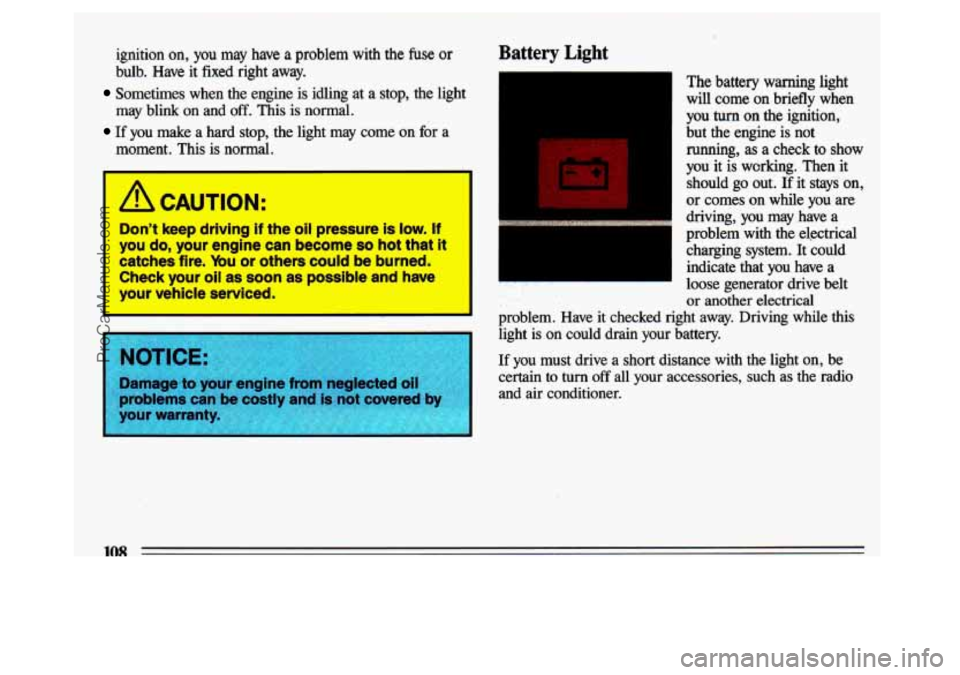
ignition on, you may have a problem with the fuse or
bulb. Have it fixed right away.
Sometimes when the engine is idling at a stop, the light
may blink on and
off. This is normal.
If you make a hard stop, the light may come on for a
moment.
This is normal.
1 A CAUTIONS
Don't keep driving if the oil pmssure is low. If
you do, your engine can become QO hot that It
catches flm. "ybu or others could be burned.
Check wur oil as soon as possible end have
your t rlcle senrlced.
I
Battery Light
The battery warning light
will come on briefly when
you
turn on the ignition,
but the engine is not
running, as a check to
show
you it is wcrking. Then it
should go out. If it stays on,
or comes on while you are
driving, you may have a
problem with the electrical
charging system. It could
indicate that you have a
or another electrical
. ., . loose generator drive belt
problem. Have it checked right away. Driving while this light is on could drain your battery.
If you must drive a short distance with the light on, be
certain to
turn off all your accessories, such as the radio
and air conditioner.
108
ProCarManuals.com
Page 111 of 324

Volts Gage (Option)
When your engine is not
running, but
the ignition is
on (in the “Run” position),
the gage shows your
battery’s state of charge
in
DC volts. When the engine
is running, the gage shows
the condition of the
charging system. Readings
between the red warning
zones indicate the normal
operating range.
Readings in either red
warning zone indicate a possible problem in the electrical
system. Have your vehicle serviced immediately.
Brake System Warning Light
Your Buick‘s hydraulic
brake system is divided into
two parts. If one part isn’t working, the other part can still work and stop you. For
good braking, though, you
need both parts working
well.
If the warning light
goes on, there could be a
brake problem. Have your
brake system inspected right away.
This light should come on
as you start the vehicle. If it doesn’t come on then, have it
fixed
so it will be ready to warn you if there’s a problem.
This light will also come on when you set your parking
brake, and will stay on if your parking brake doesn’t release
fully. If it stays on after your parking brake is
fully released, it means you have a brake problem.
If the light comes on while driving, pull
off the road and
stop carefully.
You may notice that the pedal is harder to
push. Or, the pedal may go closer to -the floor. It may take
longer to stop. If the light is still on, have the vehicle towed
for service. (See “Towing Your Buick” in the Index.)
109
ProCarManuals.com
Page 112 of 324

A CAUTION:
Your brake system may not be working properly
if the brake warning light is on.
Driving with the brake warning light on can
lead to an accident.
If the light is still on after
you’ve pulled
off the road and stopped
carefully, have the vehicle towed
for service.
Engine Coolant Temperature Warning Light
---I
This light tells you that
your engine coolant has
overheated or your radiator
cooling
fan is not working.
If you have been operating
your vehicle under normal
driving conditions, you should pull
off the road,
stop your vehicle and
turn
the engine off as soon as
possible.
HOT COOLANT CAN
BURN YOU BADLY!
In “Problems on the Road:’ this manual shows what to
do. See “Engine Overheating” in the Index.
Engine Coolant Temperature Gage (Option)
‘1 If you have the Gage
Cluster, you have a gage
that shows the engine
coolant temperature.
If the
gage pointer moves into the red area, your engine is too
hot! That reading means the same thing as the warning
light. It means that your engine coolant has
overheated. If you have
been operating your vehicle under normal driving
conditions, you should pull off the road, stop your-
vehicle and
turn off the engine as soon as possible.
Also, the temperature symbol on the gage will come on
when your engine is too hot.
HOT COOLANT CAN BURN YOU BADLY!
In “Problems on the Road:’ this manual shows what to
do. See “Engine Overheating” in the Index.
110
ProCarManuals.com
Page 113 of 324
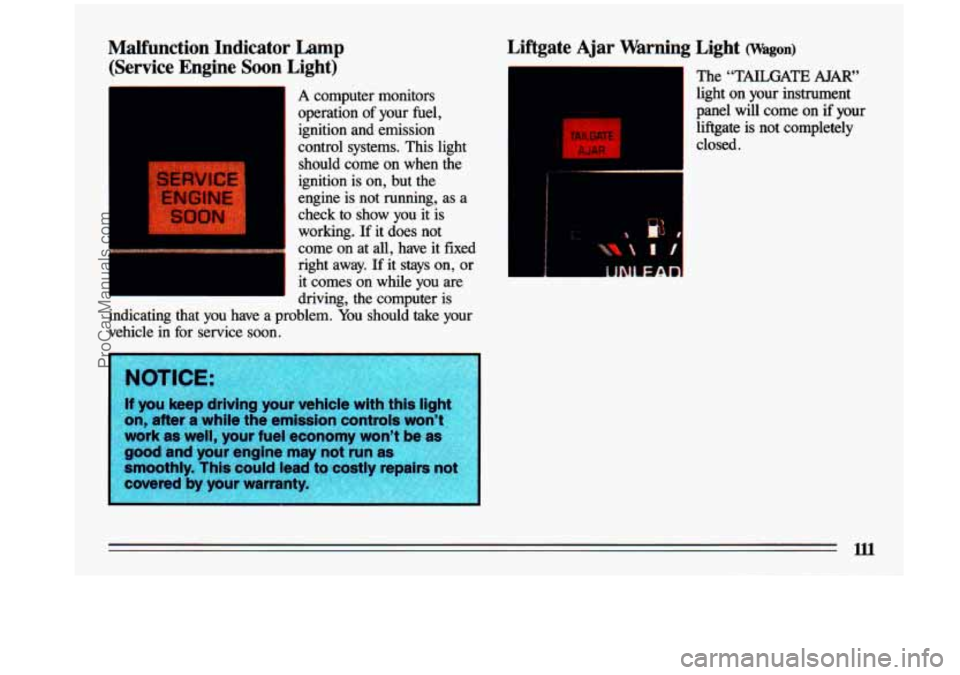
X"' 1 r-l
Malfunction Indicator Lamp
(Service Engine Soon Light)
A computer monitors
I operation of your fuel,
ignition and. emission
control systems. This light should come on when the
ignition is on, but the
engine is not running, as a
check to show
you it is
working.
If it does not
come on at all, have it fixed
right away.
If it stays on, or
it comes on while you are
driving, the computer is
I
indicating that you have a problem. You should take your
vehicle in
for service soon.
Liftgate Ajar Warning Light (Wagon)
.-
- The "TAILGATE AJAR"
~ light on your instrument
panel
will come on if your
I
TAI! GAY E
ALAR
liftgate is not completely
1 closed.
ProCarManuals.com
Page 117 of 324

The air conditioner compressor operates in all AIR COND
positions, and in DEF (Defrost) when the outside
temperature is above about 40°F (4.5"
C).
Ventilation
For mild outside temperatures, when little heating or
cooling is needed, slide the upper lever to
VENT. Air
flow is through the instrument panel outlets. Rotate the
control next to the outlets to turn on, adjust or
turn off
the air flow. Adjust the lower lever on the control panel
to the temperature desired.
Heating
When outside temperatures are cold, sliding the upper
lever to
HEATER and the lower lever to HOT will send
heated air through the heater ducts, and some through the
defroster vents.
VENT and HEAmR are labeled
ECONOMY positions because the air conditioner
compressor doesn't run
in these two settings. This
reduces engine load, resulting
in improved he1 economy.
If either setting fails to keep you comfortable, or causes
your windows
to fog up, slide the upper lever to one of
the
AIR COND positions, or to DEF (Defrost).
Defrosting
The DEF setting directs most of the air through the
defroster vents, and some through the heater ducts.
Defogging Windows with Four Season
Climate Control
To quickly defog the windshield, set the upper lever to
DEF and move the hn switch to HI. Slide the lower
lever
to HOT.
In damp, cool weather (temperatures about 45"-65"F,
7"- 18" C), you can use BI-LEV to defog the side windows.
Set the upper lever to
BI-LEV and the fan switch to HI.
Aim the side vents toward the side windows. For increased
air flow to the side vents, close the center vents.
Rear Window Defogger (Option)
--
The rear window defogger
uses
a warming grid to
remove fog from the rear
window.
In winter, it can
also keep ice from forming
on the rear window.
Press the
ON portion of the
switch. The indicator light
will glow. The rear window
defogger will
turn off
automatically after about
10
minutes of use. You can
also turn
it off by turning
off the ignition or pressing the
OFF portion of the
switch.
ProCarManuals.com
Page 119 of 324
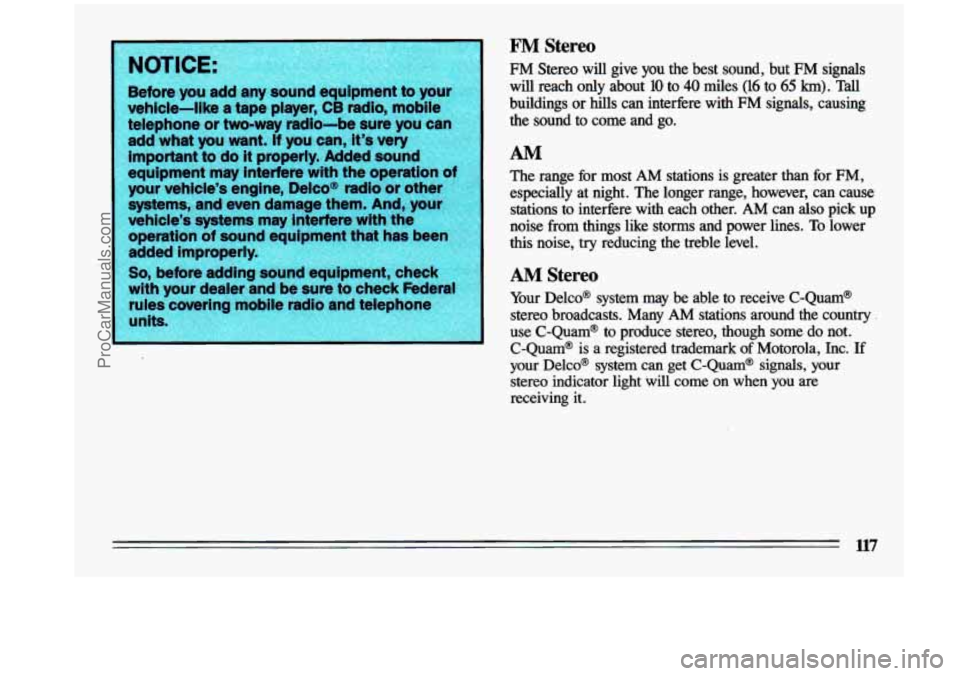
F'M Stereo
FM Stereo will give you the best sound, but FM signals
will reach only about
10 to 40 miles (16 to 65 km). Tall
buildings or hills can interfere with FM signals, causing
the sound to come and go.
AM
The range for most AM stations is greater than for FM,
especially at night. The longer range, however, can cause
stations
to inkfiere with each other. AM can also pick up
noise from things like storms and power lines.
To lower
this noise, try reducing the treble level.
AM Stereo
Your Delco@ system may be able to receive C-Quam@
stereo broadcasts. Many
AM stations around the country
use C-Quam* to produce stereo, though some do not.
C-Quam@ is a registered trademark
of Motorola, Inc. If
your Delco@ system can get C-Quam@ signals, your
stereo indicator light will come on when you are
receiving it.
ProCarManuals.com
Page 124 of 324
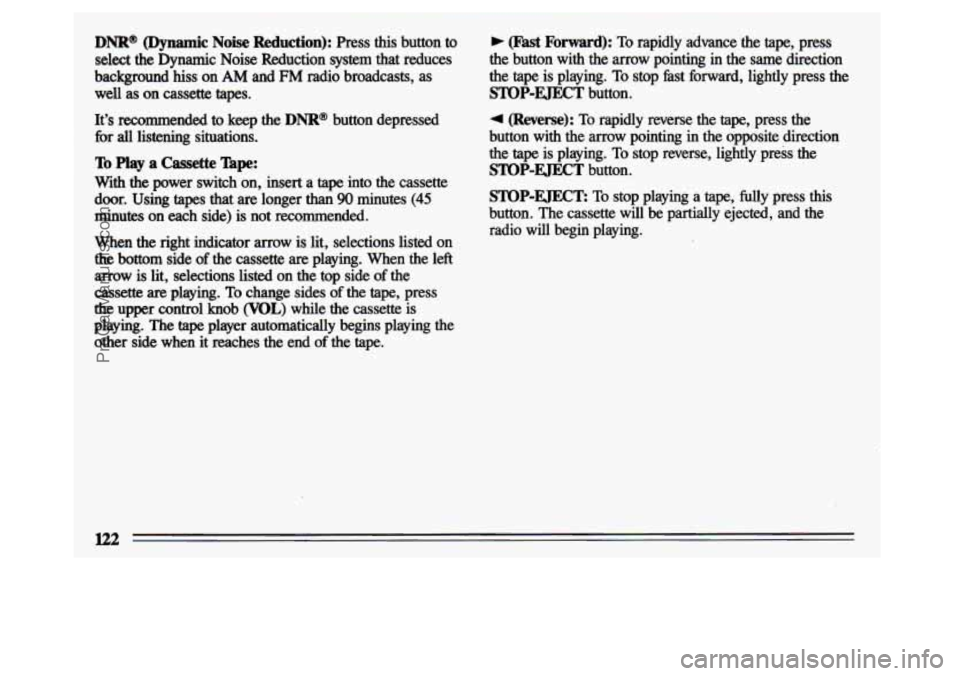
DNRB (Dynamic Noise Reduction): Press this button to
select the Dynamic Noise Reduction system that reduces
background
hiss on AM and EM radio broadcasts, as
well as on cassette tapes.
It’s recommended
to keep the DNR@ button depressed
fix all listening situations.
To Play a Cassette npe:
With the power switch on, insert a tape into the cassette
door. Using
tapes that are longer than 90 minutes (45
minutes on each side) is not recommended.
When
the right indicator arrow is lit, selections listed on
the bottom side of the cassette are playing. When the left
arrow is lit, selections listed on the top side of the
cassette
are playing. To change sides of the tape, press
the upper control knob (VOL) while the cassette is
playing.
The tape player automatically begins playing the
other side when
it reaches the end of the tape.
b (Fast Forward): To rapidly advance the tape, press
the button
with the arrow pointing in the same direction
the
tape is playing. To stop %st forward, lightly press the
STOP-EJECT button.
4 (Reverse): To rapidly reverse the tape, press the
button with the arrow pointing
in the opposite direction
the tape is playing. To stop reverse, lightly press the
STOP-EJECT button.
STOP-EJECT To stop playing a tape, fully press this
button. The cassette will be partially ejected, and the
radio will begin playing.
n2
I
ProCarManuals.com
Page 125 of 324
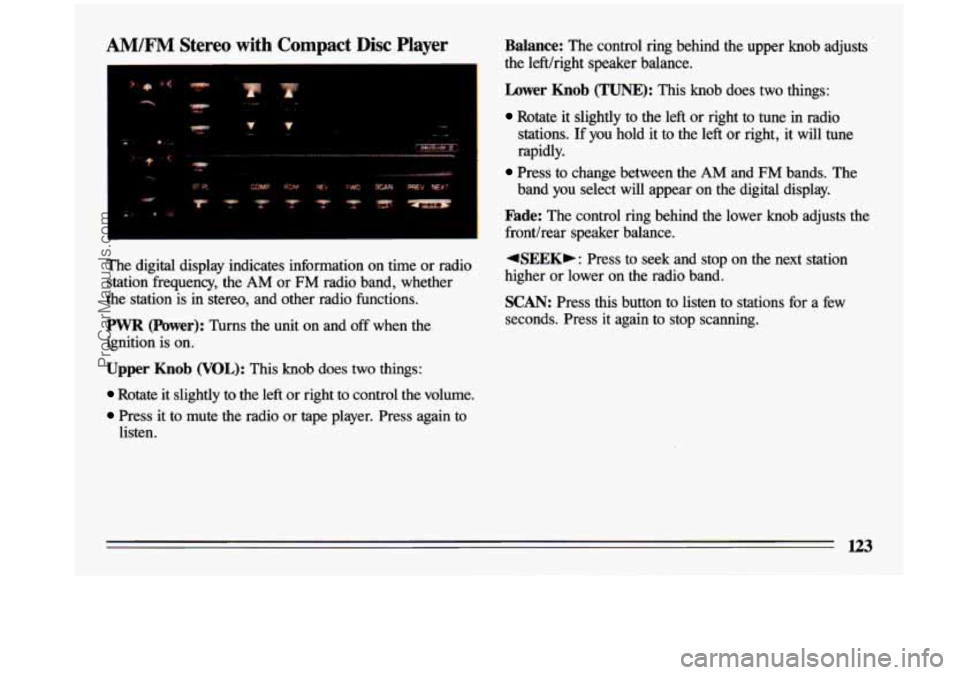
AM/F” Stereo with Compact Disc Player Balance: The control ring behind the upper knob adjusts
I the lefthight speaker balance.
The digital display indicates information on time or radio station frequency, the AM or FM radio band, whether
the station is in stereo, and other radio functions.
PWR (Power): Turns the unit on and off when the
ignition is on.
Lower Knob (TUNE): This knob does two things:
Rotate it slightly to the left or right to tune in radio
stations. If you hold it to the left or right, it will tune
rapidly.
Press to change between the AM and FM bands. The
band you select will appear on the digital display.
Fade: The control ring behind the lower knob adjusts the
fronthear speaker balance.
4SEEKb: Press to seek and stop on the next station
higher or lower on the radio band.
SCAN: Press this button to listen to stations for a few
seconds. Press it again to stop scanning.
Upper Knob (VOL): This knob does two things:
Rotate it slightly to the left or right to control the volume\
.
Press it to mute the radio or tape player. Press again to
listen.
ProCarManuals.com